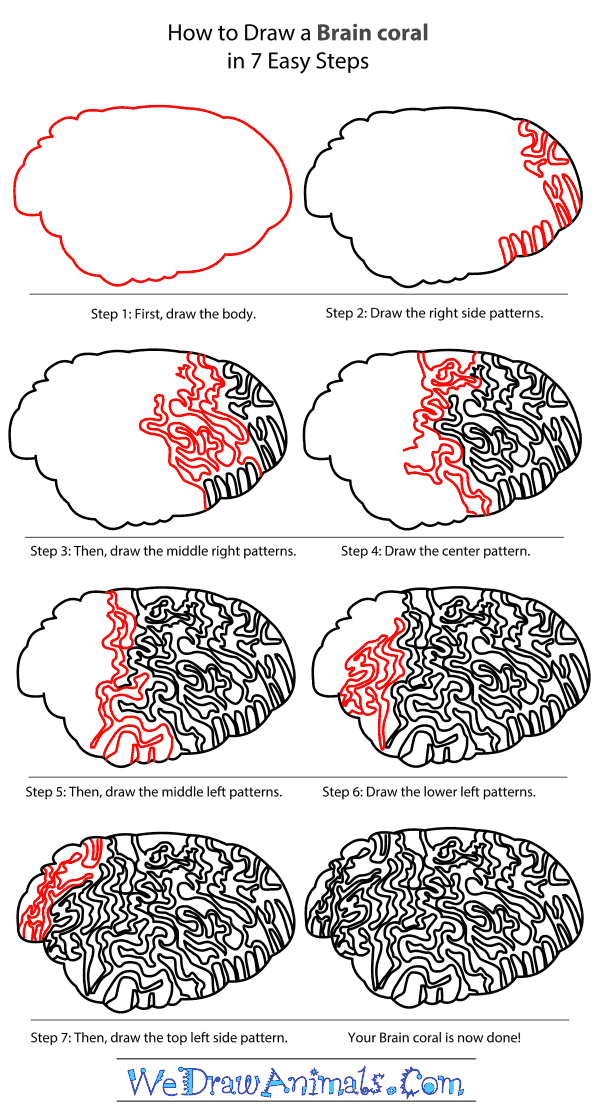In this quick tutorial you'll learn how to draw a Brain Coral in 7 easy steps - great for kids and novice artists.
The images above represent how your finished drawing is going to look and the steps involved.
Below are the individual steps - you can click on each one for a High Resolution printable PDF version.
At the bottom you can read some interesting facts about the Brain Coral.
Make sure you also check out any of the hundreds of drawing tutorials grouped by category.
How to Draw a Brain Coral - Step-by-Step Tutorial
Step 1: First, draw the outline of the dome-shaped Brain Coral’s body using a wavy line.
Step 2: Draw the grooved surface of the Brain Coral using squiggly lines. Start at the right edge of the Brain Coral and draw the lines towards the middle part.
Step 3: Continue to draw the grooved patterns in the middle right part of the Brain Coral’s body. The groove patterns make the surface of the Brain Coral look like a maze.
Step 4: Keep drawing the groove patterns in the center of the Brain Coral’s body. Make the wavy lines bigger than the lines at the edge of the coral.
Step 5: Draw the groove patterns in the left middle part of the coral’s body as shown in the image.
Step 6: Next, draw squiggly lines in the lower left part of the Brain Coral’s body.
Step 7: Finally, draw the groove patterns in the top left part of the Brain Coral’s body to complete the drawing. After you have finished drawing the Brain Coral, you can color it.
Interesting Facts about Brain Coral (Platygyra yaeyamaensis):
The Brain Coral is so called because of its resemblance to a human brain. The beautiful, twisting, maze-like grooves on the Brain Coral’s surface are actually thousands of tiny animals called coral polyps, lying close together to make up the entire coral colony. The Brain Coral takes hundreds of years to grow into an enormous mound, sometimes 7 feet in diameter and weighing several tons, and it comes in all the colors of the rainbow. Brain coral can be found in shallower warm parts of the Pacific Ocean, Indian Ocean, and Red Sea, where its massive size allows it to stand up to strong waves and ocean currents.
Did you know?
- The Brain Coral has a partnership, called symbiosis, with tiny algae that live just under the coral’s skin: The algae make food for the coral, using the sun’s energy, and feed off the coral’s waste; in return, the coral gives the algae oxygen and a safe place to live under the sea.
- On the polyps’ skin are thin, clear arms, called mesentery filaments, which reach out, squirt dissolving juices on any animals near the Brain Coral, immediately digest them, and then retract.
- The polyps of Brain Coral are nocturnal, or active at night, and more active during a full moon.
- Although Brain Coral usually reproduces by spewing eggs and sperm into the water, it is also hermaphroditic, meaning it can create an exact copy of itself without eggs and sperm; there is no visible difference between male and female coral.
- Scientists can tell the age of a coral by looking at bands on the polyps’ skeletons, just as they do by looking at the rings on a tree stump.
The suggestion of recent studies that the average global atmospheric temperature is rising has prompted scientists to predict that sea surface temperatures will also rise and have negative effects on coral development. There are other stresses to coral reefs, including poisoning and smothering from farm and factory chemicals, oil spills, and sewage, and damage from human tourists snorkeling and diving in the reefs. Many countries surrounded by coral reefs have created laws, such as Bermuda’s No Take Area laws, to help protect the growth and development of this natural resource. Time will tell how effective these laws are.








